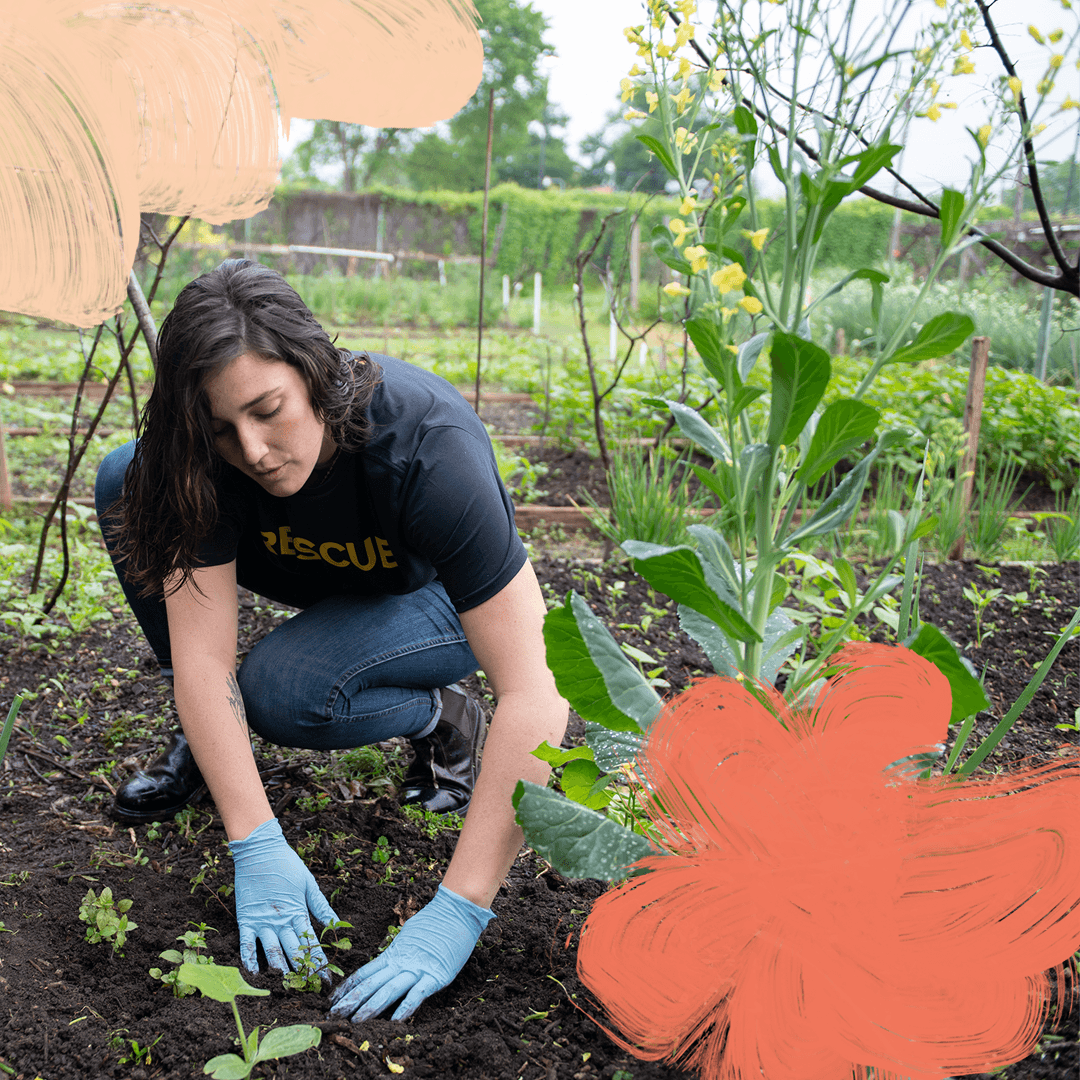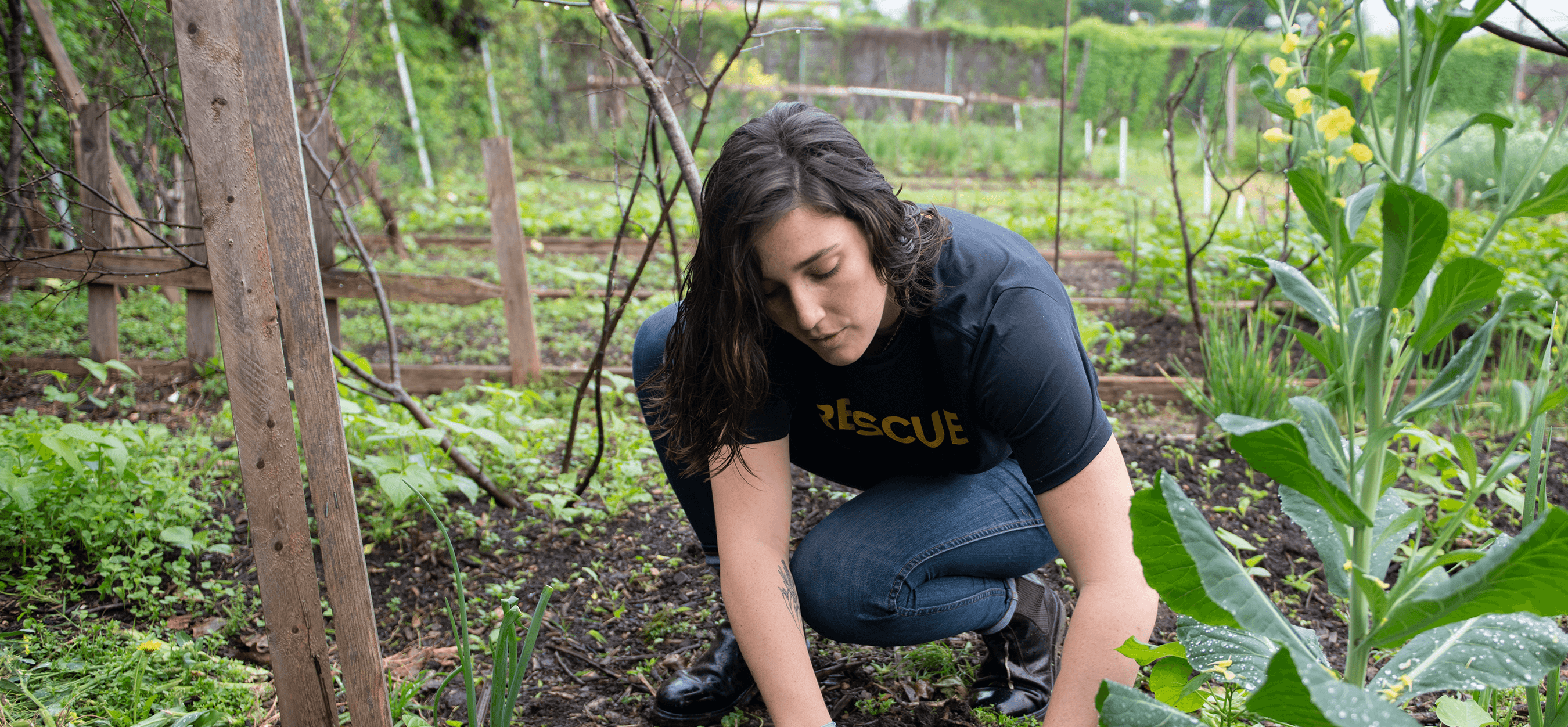
Season of Giving
How the International Rescue Committee Helps Families Grow New Roots
To learn more about how the International Rescue Committee (IRC) helps families resettle in the US (and how we can all pitch in), we sat down with Terry Allan, Senior Manager, Food & Agriculture Programs at the IRC who runs the New Roots urban agriculture program in Charlottesville, Virginia.
- Illustration
- Katie Covington Crane
When forced to flee their homes without any warning, refugees and their families can only carry so much. But refugees bring many intangible gifts to their new communities: hopes and dreams, experiences and talents, traditions and family stories, resilience and determination. Here's what we learned about their experience settling into the United States – and a few ways you can help.
On the IRC’s New Roots mission
The IRC’s New Roots urban agriculture program was started in 2013 and has 11 locations around the country. Food is the fundamental connector for people. It's not only crucial for nutrition and health, but it's a greeting card that you can offer to share your culture and hospitality with people. Generations of immigrants have come with seeds sown in their skirts and brought their cultural heritage with them to carry on their food and traditions.
While we think of the long journeys that families take to arrive in the US, the reality is that settling into a new community is just beginning. Often the first year is incredibly busy getting families into apartments and schools, finding work and accessing services. Usually, once families are more settled in the second year, schedules allow more time for gardening and building connections through the New Roots program. We see gardening as an opportunity to grow roots in the community. New Roots farms, garden plots, and markets provide space and resources for new Americans to grow, prepare, share, and sell local healthy foods.
For these refugees and immigrants, gardening is an integral part of settling in to a new community. It helps people provide nutritious food for their family, build new job and life skills, and provides unique pathways for integration. Many gardeners I work with have been growing for five or even ten years.


On the need for green spaces
The need for garden plots during the pandemic and beyond is greater than ever. In Charlottesville, we had 85 gardeners from 15 countries growing at seven locations throughout the area. On almost 3 acres, we produced 120,000 of food.
When the pandemic hit, people flooded back to one site that had become overgrown. Families cleared whole plots by hand from a foot-tall, overgrown jungle over a weekend. It was such a beautiful expression of what people wanted and needed. If you give people access to land, they know what to do. Without any meetings or planning – they cleared that ground and planted crops.
Food as cultural capital
Each of our families grows crops from their homes of origin that, typically, can't be found in American grocery stores. We call it cultural capital; they're providing something special from their own culture that they are proud to share with their family here in Charlottesville but also ship across the country.
Many of the people here were subsistence farmers or commercial growers in their previous lives, and they have so much knowledge to share. In their traditional recipes, people use pumpkin shoots, leaves, tendrils, blossoms, and of course, the fruit. When they grow beans, they eat the beans, that's for sure, but they eat also the leaves of beans. I've learned so much about expanding my dietary world from the traditional eating habits they're bringing here.
Kids in the garden
Parents and grandparents often bring their children to the garden. It was the one thing that families could do outside safely and also get some exercise during the pandemic. Now, teens are the ones getting their driver's licenses and driving their grandmothers into the garden. Kids are the future of the family that the parents are sacrificing so much for. The kids are also the ones who quickly figure out life in America, how to use all digital devices, speak English, and navigate the city. They take on a great deal of responsibility in their families.
One mother from the Democratic Republic of the Congo brings her children to the garden with her and, as they've grown, they’ve all received their own plots. One of the sons is interested in flowers and starting a flower-growing business. In his first season, he was on one of our plots and bringing his flowers to our stand at the farmer's market. In his second season, we connected him with a startup flower farm, and he's been working there and learning how to launch a flower farm from the ground up. He's getting exactly the kind of education he wanted, and we could make that connection by knowing about his passion.
What's growing this year
● African refugees typically grow eggplant, beans, corn, cassava, pumpkins, and squash.
● Bhutanese farmers grow year-round. They grow mustard greens and other cold-hardy crops through the fall and winter.
● Bitter melon attracts the most customers at the farmers' market! It's very good for your health, helping control blood sugar and blood pressure.
Harvest in the garden
In the spring, when people prepare the plots, they call in all their family members, and that's when you see the whole family. Then you see everyone again during harvest periods. Everyone comes and helps out, all the cousins and everyone, so it's really joyous when people harvest in August and September.
We had our first harvest celebration in two years this year, which was fabulous. We had about twenty gardeners come with their children and had pumpkin painting, food, drinks, and music. We also used the opportunity to discuss their vision for the garden's future.
What's next
Our vision is to secure a long-term lease, so we're not doing the vacant lot hopscotch. Our strategic plan here has been to get a lease, and build the infrastructure, like fencing and irrigation. Then, we can do programming, workshops on how to garden, festivals, and more. We're excited that we'll go through that process this year. We expect needs to grow even more next year as the Afghan families who came suddenly this year start to get settled. We're expecting these families to start signing up this coming spring and probably more next spring.
How to support refugees in your community
Talk about the refugee experience with kids as you read books together, watch movies that center on the refugee experience, and cook recipes shared by refugees.
Read:
● The Journey by Francesca Sanna
● Teacup by Rebecca Young
● Seedfolks by Paul Fleischman
● From Far Away by Robert Munsch
● I'm New Here by Anne Sibley O'Brien
● The Storyteller's Candle / La Velita De Los Cuentos by Lucia Gonzalez and Lulu Delacre
Watch:
● Encanto (again) and discuss how the Madrigals are generations of displaced people bringing gifts to their new community.
● Flee, the Sundance winner, explores the question, "What does the word 'home' mean to you?" as Amin Nawabi tells the story of his extraordinary journey as a child refugee from Afghanistan.
Simple as Water, by Oscar-winning director Megan Mylan documents Syrian families across five countries.
Cook:
● Chef Noori’s Mantu potato skins Hafeza’s Bolani recipe
Support refugee business owners and farmers. In many New Roots locations, farmers sell at local markets. In your own community, look out for and support refugee farmers.
Volunteer
There are many steps in the official process of resettlement. The IRC’s volunteers welcome families, help them settle in to new homes, bring the furniture, take people to the grocery store and support them in navigating day to day life in their new community. Find volunteer opportunities with the IRC or how to co-sponsor a family in your area.
About the IRC
In the spirit of Giving Tuesday, we're highlighting the work of the International Rescue Committee (IRC). The IRC works tirelessly to help people affected by humanitarian crises to survive, recover and rebuild their lives. From emergency food to medical care, children's education, and so much more, the IRC is committed to helping families affected by crises. Visit rescue.org to learn more.